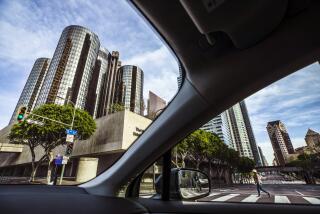San Francisco Low Season Is On, but Prices Are Up
- Share via
Deep within the number-crunching innards of the lodging industry, expert voices whisper that the best place in the country to own a hotel is near the San Francisco airport. In the first seven months of this year alone, rising demand pushed the average room rate in that area up 19.7%. Though some new hotels will add to the overall room inventory, the number of arrivals is booming at expanding San Francisco International Airport. In other words, bargains for consumers are evaporating fast.
That’s scary, of course. But what’s scarier is that the airport area, for all its price inflation, is still far more affordable than the rest of San Francisco. Weighing figures from the first seven months of this year, the hotel accounting firm PKF Consulting (which also pointed out the SFO inflation) found that the average San Francisco hotel room costs $132.70, up more than $14 from the year before. Meanwhile, the San Francisco Convention and Visitors Bureau reports that overnight stays increased 7% from 1995 to 1996, the biggest rise since 1984. Another increase is expected for this year.
This doesn’t mean you should give up. After all, there are nearly 31,000 hotel rooms in the city. But it does mean that strategic steps are in order.
First, be flexible in just about all things. Also, take heart: We’re actually heading into two of the best months of the year for finding the right San Francisco hotel. And third, consider these measures.
Consider neighborhoods: Hotels on Union Square, the epicenter of Bay Area tourism with its shopping, theaters and adjacency to convention-rich Moscone Center, tend to fill up first. Would it kill you to sleep 10 or 15 blocks away? Fisherman’s Wharf, another tourist magnet, clogs with out-of-staters in summer, but it isn’t quite so crowded the rest of the year. And the airport area, rate hikes notwithstanding, is still cheaper than most of San Francisco, with average rates about $88 per night through the first seven months of this year.
Think seasonally. Summer, obviously, is the busiest time (although visitors bureau officials say the Fourth of July and Labor Day weekends are not as busy as many people assume). But in recent years, September and October have become equally crowded, with conventioneers replacing tourists. April and May are viewed as the “shoulder season,” of medium demand. November through March is typically the period with highest availability.
Hence the special holiday offers about to kick in. To keep rooms full from mid-November through the new year, hotels throughout the city throw in perks such as free breakfast, free parking or shopping discounts, or simply lower rates. Example: From Nov. 25 to Dec. 1 and Dec. 14 to Jan. 5, the Grand Hyatt San Francisco, on Union Square, is offering a limited number of standard rooms for $129 nightly. The “off-the-rack” rate for those rooms--that is, the price in their brochures for double occupancy--is $280. An exception to the winter slowdown every year is New Year’s Eve, which usually books up tight.
Think daily. Saturdays are the worst night to find a hotel room just about everywhere in the city. (The exception is the financial district, where weekend discounts are sometimes offered by traditional business-traveler hotels.) In summertime, says hotel-room broker Mari Zatman of Golden Gate Reservations, the next busiest nights, after Saturday, are Friday and Thursday. Sunday is usually the emptiest night, and the three days that follow it can be slow too. But in convention season, Mondays and Tuesdays can get gobbled up quickly.
Beware conventioneers. For instance, even though January has been slow, Jan. 6 to 9, 1998, will be anything but. On those dates, the Mac World computer conference will bring 50,000 people to town. Then, for six days beginning Jan. 16, the Air Conditioning Assn. arrives.
Except for a conclave of 7,000 food brokers on the weekend of Dec. 6, other weekends in upcoming months look slower. If you call ahead to the visitors’ bureau information center (tel. [415] 391-2000), a representative may be able to warn you away from the largest conventions.
Don’t count too heavily on your 25%-to-50%-off discount book. Booklets like those sold by Entertainment Publications often give their biggest bargains only when hotels are expecting less than 80% occupancy. San Francisco is over that much of the time.
Consider room-broker and reservation services: These services can often get discounts and find rooms for you (or your travel agent) when hotel reservation desks are unable. Two major room brokers are based in the city. California Reservations (tel. [800] 576-0003 or [415] 252-1107) works with about 250 hotels in town and stations a staff member daily at the California Welcome Center in the Pier 39 mall at Fisherman’s Wharf.
San Francisco Reservations (tel. [800] 677-1500 or [415] 227-1500; Web site https://www.hotelres.com) handles a comparable number of hotels in and near the city. At both services, the owners recall that three years ago, they were frequently offering rooms at 50% of “rack” rates. Now those discounts are less common, and 30% off is more likely. And during peak demand, discounts can vanish.
Among the leading room brokers doing business nationally are the Central Reservation Service (tel. [800] 548-3311), Hotel Reservations Network (tel. [800] 964-6835) and Quikbook (tel. [800] 789-9887). Also, on Sept. 1 the San Francisco Convention and Visitors Bureau opened its own toll-free citywide reservations line: tel. (888) 782-9673.
Reynolds travels anonymously at the newspaper’s expense, accepting no special discounts or subsidized trips. He welcomes comments and suggestions, but cannot respond individually to letters and calls. Write Travel Insider, Los Angeles Times, Times Mirror Square, Los Angeles 90053 or e-mail chris.reynolds@latimes.com.
More to Read
Sign up for The Wild
We’ll help you find the best places to hike, bike and run, as well as the perfect silent spots for meditation and yoga.
You may occasionally receive promotional content from the Los Angeles Times.







